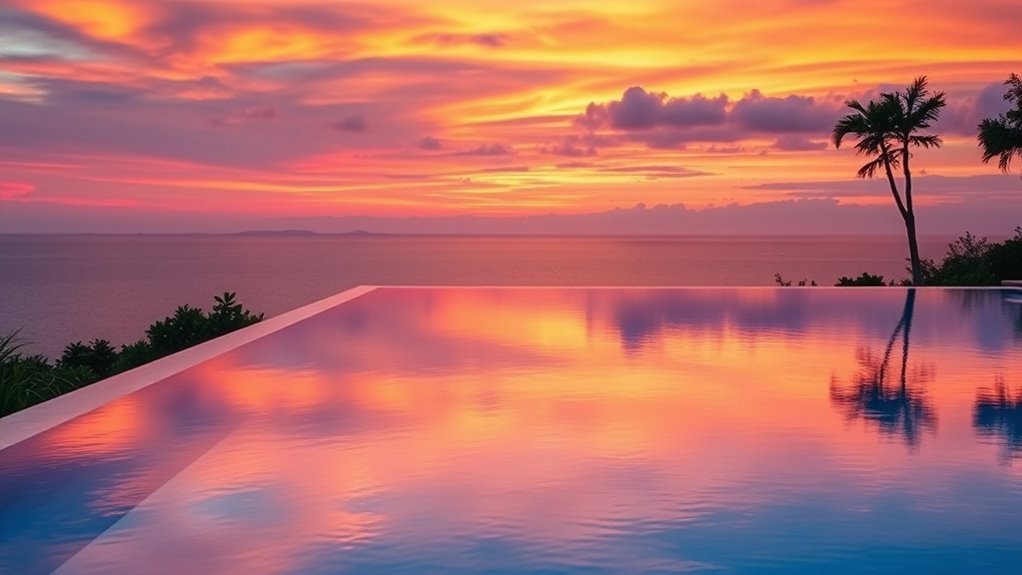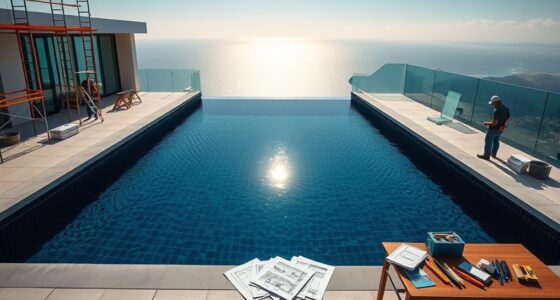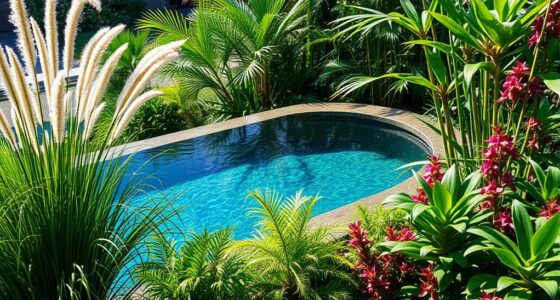To choose the best dimensions for your infinity pool, start by measuring your available space and considering landscape orientation for ideal views and sunlight. Balance proportions with common ratios like 3:1 or 4:1 for an appealing look, and determine the right depth for safety and function. Decide between standard sizes or custom options based on your budget and design goals. For tips on refining your pool’s size and features, keep exploring further.
Key Takeaways
- Measure your outdoor space accurately to ensure the pool fits comfortably with room for decks and accessibility.
- Choose dimensions with appropriate length-to-width ratios (3:1 or 4:1) for aesthetic harmony and proportional design.
- Consider desired depth and water volume to balance safety, functionality, and visual appeal.
- Opt for standard sizes for cost-effectiveness or customize dimensions to suit your landscape and specific needs.
- Plan for future features and ensure electrical/plumbing provisions to accommodate upgrades and lifestyle changes.
Assessing Your Available Space and Layout
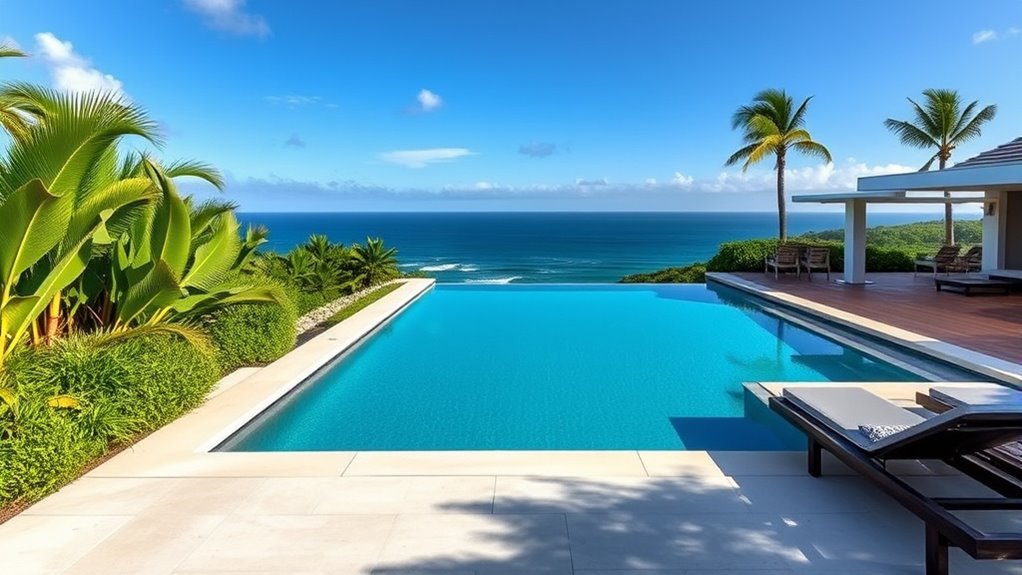
Before choosing the dimensions for your infinity pool, it’s essential to evaluate the space you have available. Measure the total area where you plan to install the pool, noting any existing structures, trees, or utilities that could limit size or shape. Consider how the pool will fit within your landscape, ensuring there’s enough room for surrounding features like decks, walkways, or seating areas. Think about accessibility, making sure you can comfortably enter and exit the pool without crowding other outdoor elements. Keep in mind the orientation toward views or sunlight, which can influence the placement and size. Taking accurate measurements now prevents future issues with space constraints or design compromises, helping you create a harmonious and functional infinity pool setup. Additionally, understanding your available outdoor space can guide you in selecting the most suitable pool dimensions and layout.
Determining Ideal Length and Width Ratios
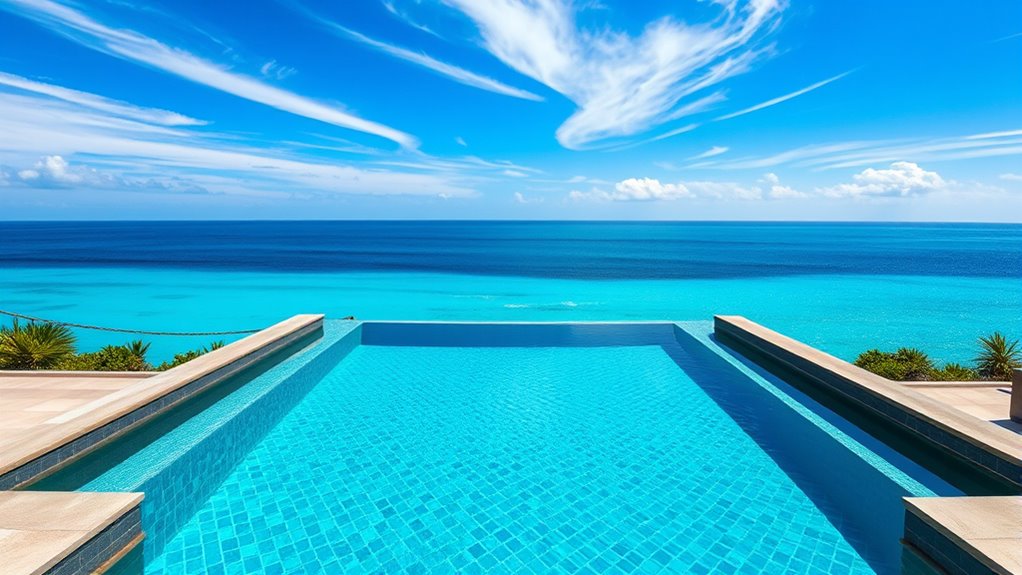
Choosing the right length and width ratios for your infinity pool is essential to achieving a balanced and visually appealing design. Typically, a ratio of 3:1 or 4:1 works well, with the length being three to four times the width. This proportion creates a sleek, modern look that feels proportional and inviting. If you want a more immersive experience, opt for a longer, narrower pool. For a more social setting, a wider pool can facilitate gatherings. Keep in mind that extremely elongated or squat shapes can look awkward or unbalanced. Consider your space’s shape and surrounding landscape to determine what ratios complement your environment. Additionally, understanding pool proportions can help you make more informed design choices. Ultimately, selecting the right proportions enhances both aesthetics and functionality, making your infinity pool a stunning focal point.
Considering Depth and Water Volume Needs
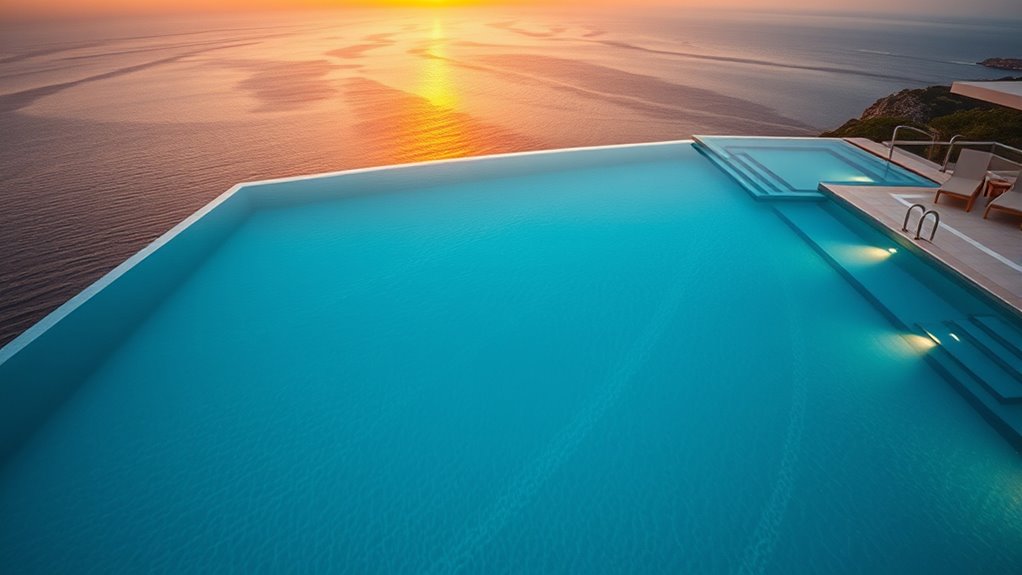
Understanding your ideal depth helps you balance comfort with safety, ensuring everyone can enjoy your pool. To do this, you need to calculate the right water volume based on your chosen dimensions. Keep safety and accessibility in mind to create a space that’s both fun and practical. Additionally, considering top beach destinations can inspire pool designs that complement your outdoor space with scenic views and a relaxing atmosphere.
Optimal Depth Guidelines
Determining the ideal depth for your infinity pool is essential to ensuring both safety and enjoyment. A common range is 4 to 6 feet, providing enough depth for comfortable swimming while maintaining safety for users of various ages. Shallow areas around 3 to 4 feet are perfect for relaxing or wading, especially if children will use the pool. Deeper sections, up to 8 feet, are suited for diving or more vigorous swimming, but require additional safety measures. Keep in mind that increasing depth also increases water volume, which impacts maintenance and filtration needs. Balancing these factors helps you select a depth that fits your intended use, safety standards, and aesthetic preferences. Ultimately, choosing the right depth enhances your pool experience without compromising safety or functionality. Additionally, understanding AI detection methods can help ensure your pool design plans meet safety and quality standards.
Water Volume Calculation
How do you guarantee your infinity pool has the right water volume for your needs? First, determine your desired pool dimensions—length, width, and depth. Multiply these to find the pool’s volume in cubic feet, then convert to gallons (multiply by 7.48). Keep in mind that increasing depth considerably raises water volume, impacting fill time and water costs. If you want a specific volume, adjust dimensions accordingly, balancing depth and surface area. For example, a shallower pool with a larger surface might provide the visual effect you want while reducing water use. Regularly measuring and recalculating helps you maintain the ideal water level, ensuring your pool functions efficiently and looks stunning. Proper volume calculation is key to a well-balanced, enjoyable infinity pool.
Safety and Accessibility
Choosing the right water volume and dimensions directly impacts safety and accessibility in your infinity pool. If the water is too deep, it can be dangerous for children or less confident swimmers. Consider a shallow end of around 3 to 4 feet for easy access and safety, especially if kids will use the pool. Adequate water volume also guarantees stability; too much can make maintenance harder and increase risks if leaks occur. Accessibility features like built-in steps, handrails, and non-slip surfaces improve safety for all users. Keep in mind that proper depth and volume help prevent accidents and make entry and exit easier. Additionally, understanding relationship patterns in angel numbers can inspire harmony and trust in your design choices. Balancing these factors ensures your pool remains a safe, enjoyable space for everyone.
Balancing Aesthetics With Functionality
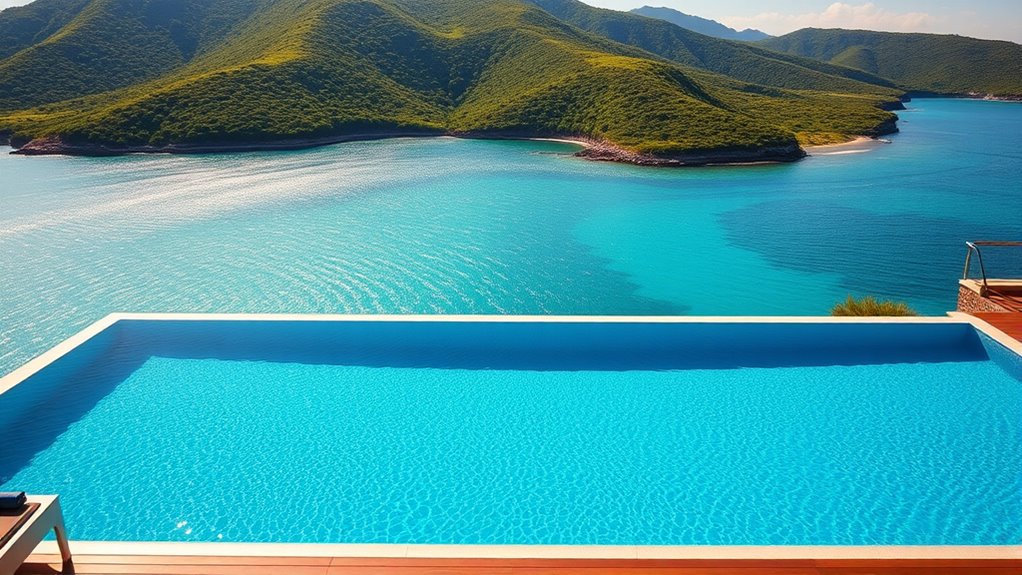
While creating an eye-catching infinity pool is important, balancing its aesthetics with everyday functionality guarantees you’ll enjoy it for years to come. You want a design that impresses but also fits your lifestyle. Consider how the pool’s shape and size affect ease of use and maintenance. For example, a sleek, minimalist look might enhance your yard’s visual appeal, but make certain there’s enough space for comfortable swimming and lounging. Think about practical features like steps, depth variations, and accessibility. Incorporate visual elements that complement your landscape without sacrificing safety or convenience. Ultimately, a well-balanced design assures your infinity pool remains a stunning centerpiece that’s also practical for daily enjoyment. Additionally, understanding how projector technology impacts viewing experiences can help you select the right equipment for outdoor entertainment spaces.
Budgeting for Construction and Maintenance
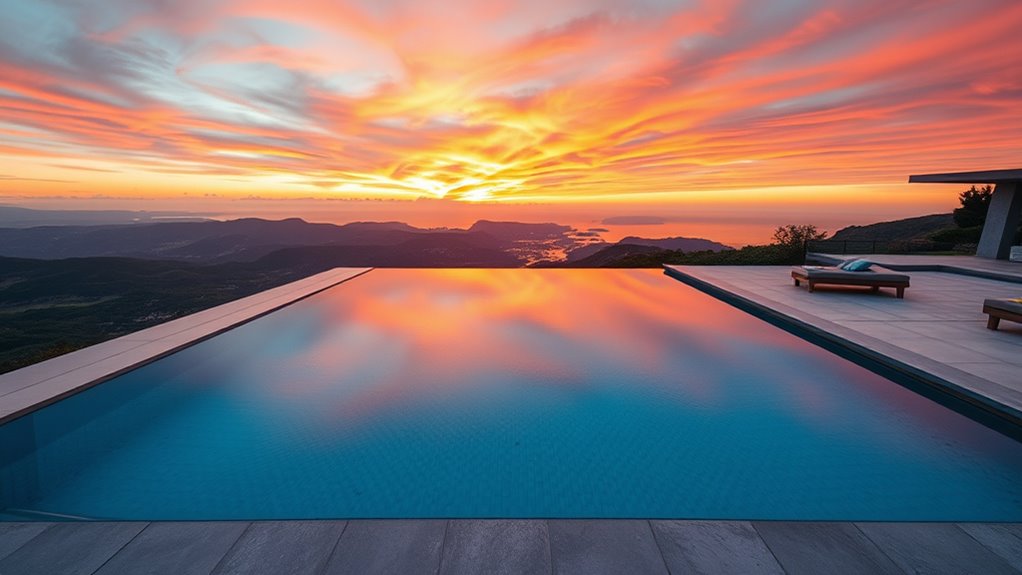
Budgeting for construction and maintenance is essential to guarantee your infinity pool remains a beautiful and functional addition to your yard. Construction costs vary based on size, materials, and site preparation, so plan carefully to avoid surprises. Larger pools and complex features increase expenses, and high-quality finishes add to the budget. Remember, ongoing maintenance is just as important—regular cleaning, chemical balancing, and equipment upkeep ensure longevity and safety. Budget for periodic repairs and potential upgrades, which can add up over time. Setting aside a contingency fund of at least 10-15% of your initial budget helps cover unexpected costs. By planning thoroughly, you’ll ensure your infinity pool stays stunning and operational without putting undue strain on your finances.
Exploring Standard vs. Custom Dimensions
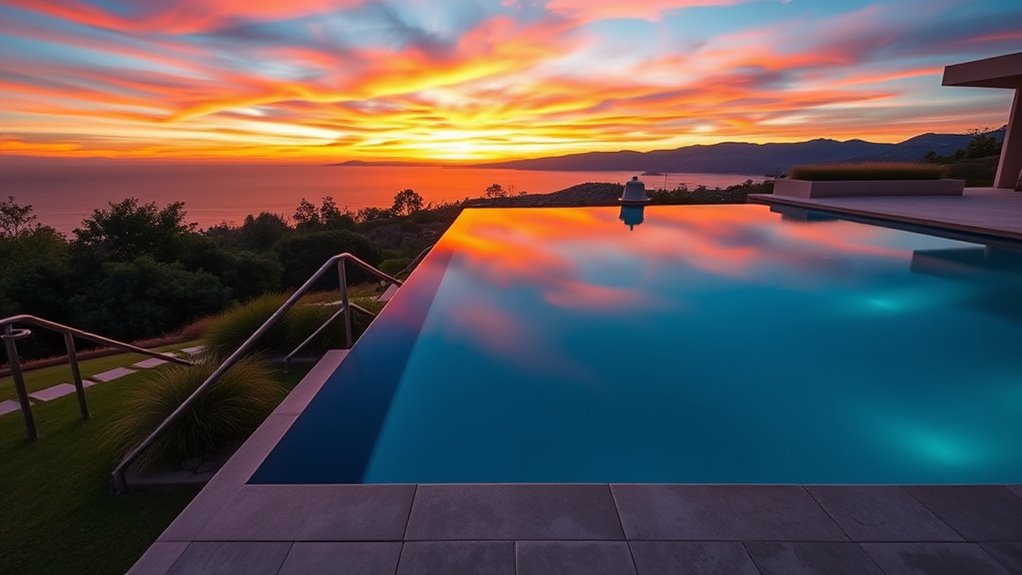
When choosing your infinity pool’s size, you’ll find options that come in standard dimensions or allow for custom measurements. Standard sizes can be more affordable and quicker to install, but they might not fit your space perfectly. Custom dimensions offer flexibility but often come with higher costs and longer construction times. Additionally, considering ventilation considerations can help ensure your pool area remains comfortable and well-maintained.
Standard Size Options
Are standard pool sizes enough to meet your needs, or should you consider custom dimensions? Standard options are widely available and often more affordable, making them a practical choice for many homeowners. They come in common sizes like 10×20 feet, 12×24 feet, or 15×30 feet, which suit most backyard spaces and budgets. These pre-designed dimensions are tested for durability and safety, simplifying installation. Additionally, understanding self watering plant pots can inform your landscaping choices and help create a more sustainable and low-maintenance outdoor environment. However, they might not fit unique yard layouts or specific aesthetic preferences. When choosing a standard size, consider:
- Your available outdoor space
- Intended use (lap swimming, lounging, entertaining)
- Local building codes and restrictions
Standard sizes offer convenience but may limit personalization, so assess your needs carefully before deciding.
Customization Flexibility
While standard pool sizes offer convenience and affordability, they may not always align perfectly with your unique yard layout or personal aesthetic preferences. Customizing your infinity pool allows you to tailor its dimensions to fit your space precisely, ensuring it complements your landscape and architectural style. You have the flexibility to choose specific lengths, widths, and depths that maximize visual appeal and functionality. This level of customization also enables you to incorporate features like built-in seating, steps, or integrated spa areas. By opting for custom dimensions, you gain greater control over your pool’s design and how it fits within your outdoor environment. Additionally, understanding narcissistic behaviors can help inform your design choices to create a space that feels authentic and satisfying to your personal style. Ultimately, this flexibility helps create a truly personalized oasis that meets your exact desires and enhances your property’s overall beauty.
Cost Implications
Choosing the right dimensions for your infinity pool directly impacts your budget, as costs can vary substantially between standard and custom options. Standard sizes are more affordable because they use off-the-shelf materials and easier construction processes. Custom dimensions, however, require specialized design, unique materials, and additional labor, which increase costs.
Consider these cost factors:
- Material expenses: Custom pools often need premium materials to match specific sizes.
- Design complexity: Unique shapes or sizes demand more planning and skilled labor.
- Installation time: Longer construction periods for custom pools can increase labor costs and project timelines.
Balancing your desired size with your budget ensures you make a practical investment without sacrificing quality or aesthetics.
Planning for Future Expansion or Features
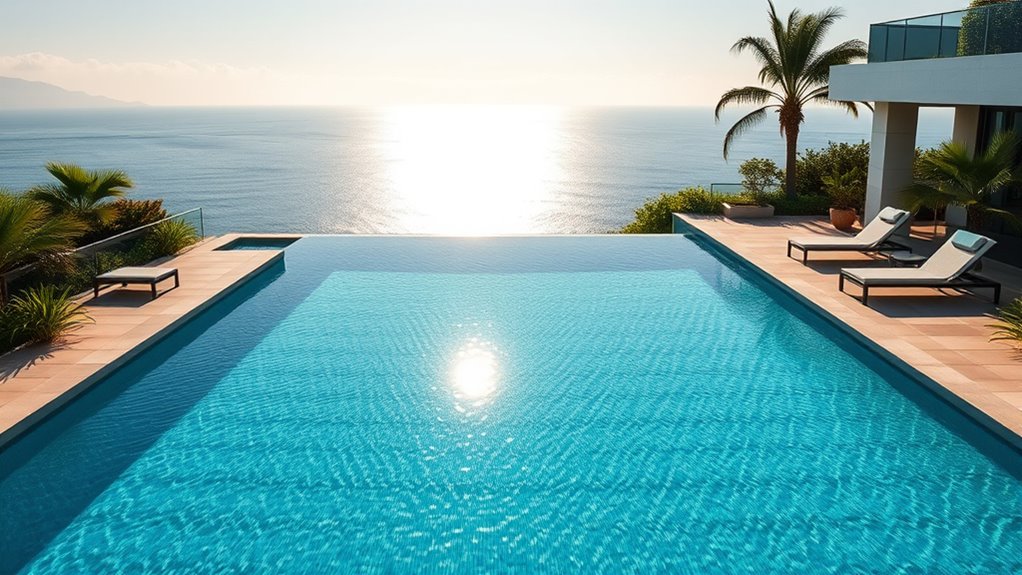
Planning for future expansion or additional features guarantees your infinity pool remains functional and stylish as your needs evolve. When designing, consider leaving extra space around the pool to accommodate larger seating areas, waterfalls, or spa features later on. Think about how your family’s lifestyle might change—maybe you’ll want to add a hot tub or built-in loungers down the line. Incorporate electrical and plumbing provisions now if you plan to upgrade equipment or add lighting. By planning ahead, you avoid costly renovations later. Keep in mind that larger dimensions can make future modifications easier, ensuring your pool adapts seamlessly to new features. Additionally, understanding the appropriate dimensions for your space can help optimize both aesthetics and functionality over time. Thoughtful planning now saves money and effort, giving you a versatile, long-lasting infinity pool that grows with your vision.
Frequently Asked Questions
How Do Local Building Codes Affect Infinity Pool Dimensions?
Local building codes set safety and structural standards that directly impact your infinity pool’s dimensions. You need to verify your pool’s size, depth, and edge design comply with regulations to avoid fines or delays. These codes may specify minimum or maximum sizes, fencing requirements, or safety barriers. Always check with your local authorities before finalizing your plans, so you can design a pool that’s both beautiful and compliant.
What Safety Guidelines Should Influence Pool Size Choices?
You should prioritize safety guidelines that could turn your pool into a fortress of protection. Always guarantee your pool is large enough to avoid overcrowding and allow safe movement, especially for kids and seniors. Install proper fencing, alarms, and anti-slip surfaces. Keep depth markers visible and meet local safety standards. These precautions turn your luxurious infinity pool into a safe haven where relaxation and safety go hand in hand.
How Do Climate Conditions Impact Pool Depth and Volume?
Climate conditions directly influence your pool’s depth and volume. In hot, sunny areas, you’ll want a larger volume to keep the water cooler and reduce evaporation. If you experience cold seasons, deeper sections can help retain heat and prevent freezing. Additionally, windier climates may require increased volume to counteract temperature drops and maintain water quality. Adjusting your pool’s size guarantees comfort, safety, and longevity in your specific environment.
Can Optimal Dimensions Vary by Pool Shape and Design?
Yes, your pool’s best dimensions can vary based on its shape and design. For example, rectangular pools often maximize space and usability, while freeform designs may prioritize aesthetics over size. You should consider your intended use, space available, and visual appeal when determining dimensions. Working with a designer can help you find a balance that complements your landscape and meets your functional needs, ensuring your pool looks great and functions well.
What Are Common Pitfalls in Selecting Pool Dimensions?
You risk turning your stunning infinity pool into a disaster if you ignore common pitfalls. Avoid making it too small, which can feel cramped and limit enjoyment, or too large, which drives up costs exponentially. Don’t forget to take into account depth and slope, or you might compromise safety and aesthetics. Always measure carefully, plan for maintenance, and consult experts to prevent these costly mistakes from turning your dream into a nightmare.
Conclusion
Choosing the right dimensions for your infinity pool is like planting a seed—you’ll nurture it to grow into a stunning centerpiece. By balancing space, style, and function, you’re setting the foundation for a tranquil oasis that mirrors your vision. Remember, your pool is more than water and edges; it’s a horizon where dreams meet reality. With thoughtful planning, your infinity pool will stand as a symbol of serenity, inviting endless moments of reflection and beauty.
